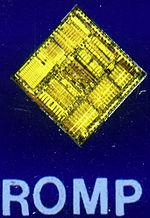
ROMP
Encyclopedia

Microprocessor
A microprocessor incorporates the functions of a computer's central processing unit on a single integrated circuit, or at most a few integrated circuits. It is a multipurpose, programmable device that accepts digital data as input, processes it according to instructions stored in its memory, and...
designed by IBM
IBM
International Business Machines Corporation or IBM is an American multinational technology and consulting corporation headquartered in Armonk, New York, United States. IBM manufactures and sells computer hardware and software, and it offers infrastructure, hosting and consulting services in areas...
in the early 1980s manufactured on a 2 µm process with 45,000 transistors.
ROMP also known in some circles as 032, was first in silicon in 1981 and was originally designed to be used in office products. It was intended as a follow-on to a mid-1970's processor called the "OPD Mini Processor", which was used in text editing systems such as the IBM Office System/6. ROMP originally was shipped in the IBM RT/PC line, announced in 1986, and was later used in an IBM laser printer. For a time the IBM RT/PC was planned to be a personal computer, with ROMP replacing the Intel 8088. However, the software was targeted more towards engineering workstations.
The original ROMP had a 24-bit Reduced Instruction Set Computer (RISC) architecture developed by IBM, but the instruction set was changed to 32 bits a few years into the development. It was originally implemented in a 2 µm NMOS
NMOS logic
N-type metal-oxide-semiconductor logic uses n-type metal-oxide-semiconductor field effect transistors to implement logic gates and other digital circuits...
technology. It had sixteen 32-bit general purpose registers and used 32-bit addresses and data paths. The microprocessor was controlled by 118 simple two- and four-byte instructions. Internal processor organization enabled the CPU to execute most register-to-register instructions in a single cycle. An IBM-developed advanced memory management chip provided virtual memory address translation functions and memory control.
The architectural work started in late spring of 1977, as a spin-off of the T.J. Watson Research 801
IBM 801
The 801 was an experimental minicomputer designed by IBM. The resulting architecture was used in various roles in IBM until the 1980s. The 801 was started as a pure research project led by John Cocke in October 1975 at the Thomas J. Watson Research Center. The name 801 comes from the building the...
processor (hence the "Research" in the acronym). Most of the architectural changes were for cost reductions, such as adding 16-bit instructions for byte-efficiency - a main concern at the time. For embedded systems, this is still a concern; ARM
ARM architecture
ARM is a 32-bit reduced instruction set computer instruction set architecture developed by ARM Holdings. It was named the Advanced RISC Machine, and before that, the Acorn RISC Machine. The ARM architecture is the most widely used 32-bit ISA in numbers produced...
, MIPS
MIPS architecture
MIPS is a reduced instruction set computer instruction set architecture developed by MIPS Technologies . The early MIPS architectures were 32-bit, and later versions were 64-bit...
and Power Architecture
Power Architecture
Power Architecture is a broad term to describe similar RISC instruction sets for microprocessors developed and manufactured by such companies as IBM, Freescale, AMCC, Tundra and P.A. Semi...
have all added 16-bit instructions to their architectures, which were originally 32-bit only.
The first chips were ready in early 1981. Thus, ROMP was possibly the first working commercial RISC, depending on whether or not it was a true RISC and whether or not one could count it as a commercial product in 1981, since it didn't actually ship until 1986. This delay was caused by overly ambitious software plans for the RT/PC and its operating system
Operating system
An operating system is a set of programs that manage computer hardware resources and provide common services for application software. The operating system is the most important type of system software in a computer system...
(OS). This OS virtualized the hardware and could host multiple other operating systems, though UNIX was the only operating system to be ported to the underlying virtual OS. This technology, called virtualization, while commonplace in mainframe
Mainframe computer
Mainframes are powerful computers used primarily by corporate and governmental organizations for critical applications, bulk data processing such as census, industry and consumer statistics, enterprise resource planning, and financial transaction processing.The term originally referred to the...
systems, only began to gain traction in smaller systems in the 21st century. The IBM RT/PC consequently fell behind competitors such as Sun Microsystems
Sun Microsystems
Sun Microsystems, Inc. was a company that sold :computers, computer components, :computer software, and :information technology services. Sun was founded on February 24, 1982...
and Apollo Computer
Apollo Computer
Apollo Computer, Inc., founded 1980 in Chelmsford, Massachusetts by William Poduska and others, developed and produced Apollo/Domain workstations in the 1980s. Along with Symbolics and Sun Microsystems, Apollo was one of the first vendors of graphical workstations in the 1980s...
who ported UNIX directly to their platforms.

